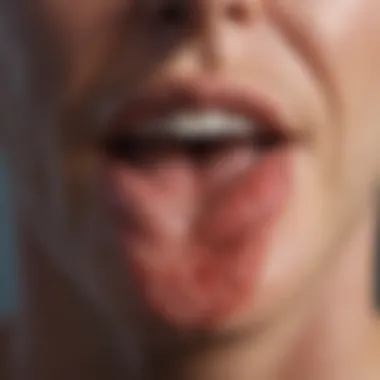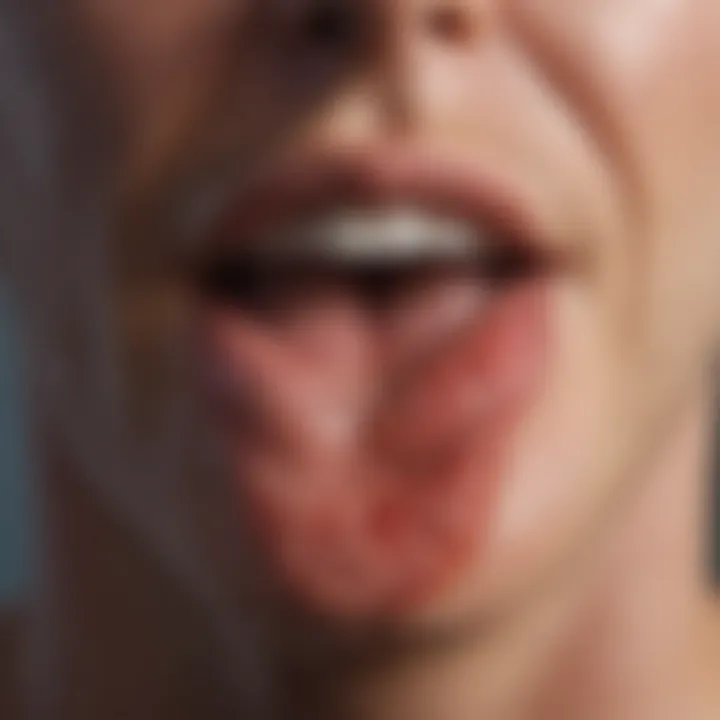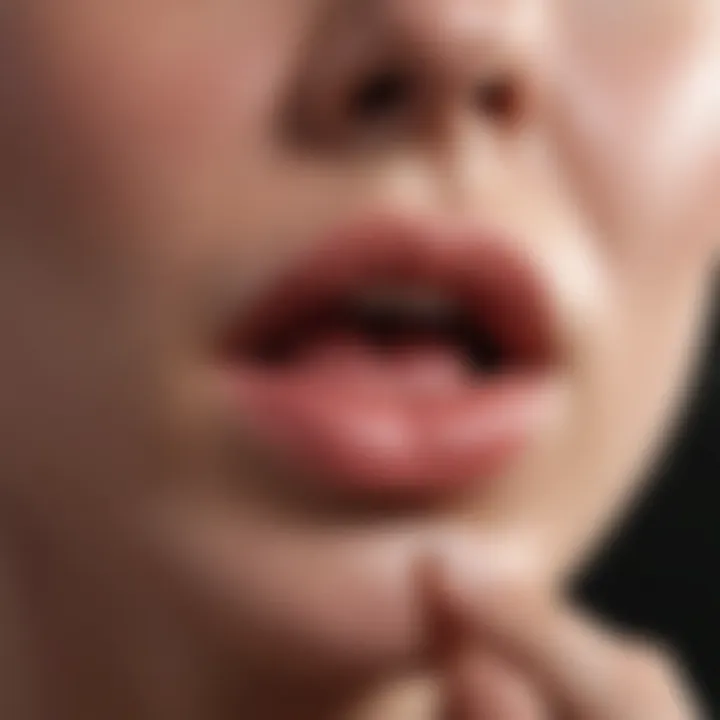Understanding Cold Sores: Causes and Treatments


Intro
Cold sores, often dubbed fever blisters, pop up uninvited and linger long after the party is over. While they might seem just a minor annoyance, these lesions carry a wealth of implications that extend beyond their appearance. Associated with the herpes simplex virus (HSV), cold sores can cause discomfort, and embarrassment, and occasionally hint at deeper health issues. The vital piece here is comprehending not only what brings them about but also how to effectively tackle them when they strike.
The community around cold sores is vast, touching health professionals, wellness coaches, and everyday individuals. From uncovering the trigger factors—be it stress, seasonal changes, or immune system dips—to learning about medicinal solutions and lifestyle adjustments, this article aims to guide readers through the maze of information surrounding cold sores. This knowledge is crucial, as it can empower individuals to reclaim control over their health and well-being.
As we peel back the layers on cold sores, the ensuing sections will illuminate the key benefits derived from understanding and addressing this common ailment, as well as practical approaches to both treatment and prevention. Understanding cold sores and their solutions is not just about managing outbreaks; it’s about enhancing the overall quality of life.
Prelude to Cold Sores
Cold sores, also known colloquially as fever blisters, hold a mix of discomfort and social stigma for many individuals. They are small, fluid-filled blisters that typically manifest around the lips but can appear in other areas of the face as well. The importance of understanding cold sores stems not just from the physical discomfort they cause, but also the social and emotional implications they entail. This article aims to dissect the various facets of cold sores, equipping readers with knowledge not only to recognize symptoms but also to explore an array of therapeutic solutions available.
Understanding cold sores is crucial as they are a prevalent condition affecting a significant portion of the population at some point in their lives. The implications of this virus go beyond mere aesthetics; cold sores can lead to feelings of anxiety or embarrassment, particularly during an outbreak. With proper knowledge and preventive measures, individuals can manage symptoms more effectively and diminish the frequency of outbreaks.
As we navigate through the sections that follow, the goal is to paint a comprehensive picture encompassing the viral origins, an overview of symptoms, and a deep dive into the treatment landscape—both medicinal and alternative remedies.
Definition and Overview
What Are Cold Sores?
Cold sores are caused by the herpes simplex virus, most commonly type 1 (HSV-1). They are characterized by painful blisters that often appear on or around the lips. The symptoms typically begin with a tingling or burning sensation around the mouth before the blisters erupt. These sores can last from several days to two weeks, causing discomfort as they crust over and heal.
Etiology of Cold Sores
The herpes simplex virus is highly contagious. Once contracted, the virus remains dormant in the body’s nerve cells and can reactivate later due to various triggers such as stress, illness, or sun exposure.
Epidemiology and Prevalence
Cold sores are alarmingly common. According to various studies, as much as 67% of the global population carries HSV-1, whether they exhibit symptoms or not. This makes understanding their behavior, treatment, and prevention even more essential.
- Demographic Insights: Cold sores can affect individuals across all age groups, with first-time infections often occurring during childhood. Interestingly, not everyone who gets infected will experience noticeable outbreaks.
- Statistics and Trends:
- In the United States alone, approximately 50-80% of adults have oral herpes, and a significant number will experience multiple outbreaks throughout their lives.
- Factors such as environment, seasons, and even geographical location can influence the prevalence of cold sores, making it crucial for individuals to be aware of their potential triggers.
Understanding the epidemiology and prevalence helps in combating the stigma surrounding this common condition. This knowledge empowers individuals with the ability to discuss and manage their experiences candidly.
With this groundwork laid out, it’s time to delve deeper into the herpes simplex virus itself, understanding its types and the contagion that spreads it.
The Herpes Simplex Virus
When discussing cold sores, it is essential to address the root cause: the herpes simplex virus (HSV). This virus plays a pivotal role in understanding not just the symptoms and outbreaks associated with cold sores, but also the broader implications for health and lifestyle. By grasping the specifics of HSV, individuals can make informed choices regarding treatment and prevention. Ultimately, this knowledge empowers readers to manage and mitigate their outbreaks effectively.
Types of Herpes Simplex Virus
There are two primary types of herpes simplex virus. Both can lead to outbreaks, but they differ in their commonality and the areas they typically affect:
- HSV-1: This type is most commonly associated with cold sores. Primarily, it results in lesions around the mouth and lips, but it can occasionally lead to genital infections as well. HSV-1 is often transmitted through oral-to-oral contact, such as kissing or sharing personal items like utensils or lip balm.
- HSV-2: This strain is generally linked to genital herpes. It's less common for HSV-2 to cause cold sores but still possible. Transmission usually occurs through intimate contact, making it particularly important for sexually active individuals to be aware of the risks and signs.
Both types are lifelong infections, meaning once a person contracts the virus, it remains dormant in the body and can reactivate under certain circumstances.
Transmission and Contagion
Understanding how herpes simplex viruses are transmitted can help mitigate the risk of spreading the infection. The viruses are contagious, particularly when symptoms are present, but they can also be transmitted even when an infected person shows no visible signs. Here are some critical points to consider:
- Direct Contact: HSV spreads primarily through direct contact with an infected area. This can occur during kissing, oral sex, or by touching the sores and then touching another person.
- Asymptomatic Shedding: Even when a person is not experiencing an outbreak, the virus can still be present on the skin and potentially infectious. It’s important to recognize that transmission can happen unknowingly.
- Contagion Timeline: The hours and days before and after the appearance of sores are critical. Notably, the highest risk of spread occurs when there is an outbreak. However, precautionary measures should be taken at all times to reduce the risk of contagion.
"Awareness of how HSV is transmitted can greatly reduce the risk of spreading the virus to others and help those with cold sores feel more in control of their condition."
Knowing these factors and how they relate to everyday interactions can inform lifestyle choices that might minimize outbreaks and prevent transmission.
Understanding the intricacies of the herpes simplex virus not only helps in managing cold sores effectively but also promotes a broader comprehension of intimate health. This knowledge is crucial for healthcare professionals, wellness coaches, nutritionists, and fitness trainers who guide individuals toward healthier lives.
Identifying Cold Sores
Identifying cold sores is a crucial aspect of understanding this common viral condition. Cold sores can pop up at the most unexpected times, often catching individuals off guard. Proper identification not only assists in managing outbreaks but also helps in preventing the spread of the virus to others. Knowing the signs and symptoms, as well as the progression through various stages, is beneficial for those who experience recurrent episodes. Awareness can enhance a person's ability to respond effectively to an outbreak, allowing for timely management and treatment.
Symptoms and Signs
Cold sores, primarily caused by the herpes simplex virus type 1, manifest through a range of symptoms that can be subtle at first. Early signs often include a tingling or burning sensation around the affected area—this prodromal phase is a critical time. People might dismiss this initial discomfort, but it serves as an alert that a flare-up may be imminent.


As the outbreak progresses, you might witness:
- Red blisters around the mouth or on the face.
- Croaky mouth or periods of sensitivity on the lips.
- A possible fever and swollen lymph nodes when the outbreak is more severe.
Blisters typically rupture within a day or two, leading to painful sores that can be crusty and unsightly. The healing stage can take up to two weeks or longer, depending on the individual's immune response.
"Recognizing the symptoms early can give you a fighting chance to mitigate the infection's intensity and duration."
Stages of Outbreak
Understanding the stages of a cold sore outbreak can further aid in effective management. Most outbreaks can be broken down into four primary phases:
- Prodromal Stage: This is where the first signs, such as tingling or itching, appear. It can last anywhere from a few hours to a day.
- Blister Stage: Here, red blisters form, often filled with fluid. They are notably painful and itchy, signaling a full-blown outbreak.
- Weeping Phase: Once the blisters burst, the fluid may ooze from them. This stage is highly contagious, and taking precautions is essential.
- Crusting Stage: Finally, the sores scab over and start to heal. The last remnants might linger for up to two weeks, but they typically do not pose a health concern.
Each of these stages presents an opportunity for intervention. Whether it’s starting antiviral medication or utilizing natural remedies, being aware of where you stand in this cycle can significantly affect the outcome of the outbreak.
By honing in on the symptoms and stages of cold sores, individuals become empowered in their management of this condition, making informed decisions that affect both personal health and communal well-being.
Standard Medicinal Treatments
When it comes to cold sores, the role of standard medicinal treatments cannot be overstated. These treatments not only provide relief from the symptoms but also play a crucial role in managing outbreaks and minimizing the frequency of recurrences. Understanding the various medicinal options available helps individuals make informed choices that cater to their specific needs and conditions.
Antiviral Medications
Overview of Common Antivirals
At the forefront of treating cold sores are antiviral medications, a staple in the therapeutic arsenal against the herpes simplex virus. Acyclovir, Valacyclovir, and Famciclovir are the most common antivirals prescribed. Each has its nuances in how it works, but their main contribution is to halt the replication of the virus. This is particularly advantageous as it not only reduces the severity of symptoms but also accelerates healing. One key characteristic of these antivirals is their ability to be taken orally, which makes them convenient for patients who may prefer not to deal with topical applications.
However, while the efficacy of these medications is notable, it’s essential to be aware of the specific features. For instance, Acyclovir pill form may need to be consumed multiple times a day, which can be seen as a disadvantage for those with hectic schedules. Valacyclovir offers less frequent dosing, improving adherence to the treatment plan, making it more favorable for many.
Dosage and Administration
Correct dosage and administration of antiviral medications are instrumental for maximizing their effectiveness. Most antiviral protocols suggest initiating treatment at the first sign of an outbreak, typically when tingling or itching sensations occur. For example, Acyclovir is often prescribed at a dosage of 200 mg five times daily for five days, dependent on the patient’s history with outbreaks.
A significant characteristic of dosage is that the timing can significantly affect the outcome of treatment. If a patient starts taking them too late in the outbreak cycle, the benefits may be diminished. This highlights the importance of early recognition of cold sore symptoms and having medication on hand. While taking an antiviral orally is straightforward, patients may face gastrointestinal discomfort, which could affect adherence.
Potential Side Effects
As with any medication, antiviral drugs come with potential side effects that shouldn’t be overlooked. Common adverse reactions include nausea, diarrhea, and headaches. While these are generally mild, they can be distressing enough for some individuals to seek alternatives. Importantly, those with a history of kidney issues must consult a healthcare provider before starting these medications, as improper usage may lead to complications.
An understanding of these side effects is crucial for patients because it informs them about what to expect and encourages open discussion with healthcare providers about any concerns. It is always wise to weigh the benefits against the side effects and consider personal health history when opting for antiviral therapy.
Over-the-Counter Options
Topical Creams and Ointments
For those who prefer not to dive headfirst into systemic treatments, over-the-counter topical options present an appealing alternative. Creams and ointments that contain ingredients like Docosanol or Zinc Oxide can empower individuals to manage symptoms effectively. These topical remedies work by creating a barrier, thus slowing down virus replication and soothing the affected areas.
One of the appealing aspects of topical treatments is their localized effect; they deliver relief right where it's needed without systemic side effects. However, while users may appreciate their ease of access and use, the downside is that these treatments might not provide substantial relief for severe outbreaks. Consistency in application is key for effectiveness, which can be a challenge for some patients.
Pain Relief Solutions
In addition to direct antiviral treatments, many individuals seek solutions for pain relief associated with cold sores. Non-prescription pain relief methods, including Ibuprofen or Acetaminophen, are commonly utilized to alleviate discomfort. These solutions can be essential for those who experience significant pain during outbreaks and need immediate relief to carry on with daily activities.
The benefit of these pain relief solutions is their availability and effectiveness in managing pain. However, it is vital to use them judiciously to prevent dependency or excessive use, particularly among those who may require regular relief during frequent outbreaks.
Ultimately, the right approach to treating cold sores is often a mix of different therapies tailored individually. Understanding standard medicinal treatments helps patients navigate their options and supports informed decisions to take control of their health.
Alternative and Natural Remedies
Exploring alternative and natural remedies for cold sores provides a valuable perspective beyond conventional medicine. These methods highlight the power of nature and lifestyle in managing outbreaks. Utilizing holistic approaches can complement antiviral treatments and potentially lessen the frequency of recurrences.
Many individuals seek out these remedies not just due to personal belief but as a response to side effects from standard treatments. Natural solutions might resonate well with the health-conscious, offering ways to promote wellness through diet and natural products.
Herbal Treatments
Properties of Lemon Balm
Lemon balm, known for its soothing attributes, is a herb frequently discussed in the context of cold sores. Its antiviral properties are particularly noteworthy. Studies show that applying lemon balm extract may reduce the duration of outbreaks. The key characteristic of lemon balm is its ability to calm inflammation and provide relief from symptoms like itching and discomfort.


This herb acts specifically on herpes simplex viruses, making it a popular choice among those looking for a natural remedy. A unique feature of lemon balm is its pleasant lemony aroma, which adds to its appeal when used in topical applications.
While it presents numerous advantages, such as being easy to find and applying without complicated procedures, a few may find that it doesn’t work as swiftly as some pharmaceutical options.
Benefits of Tea Tree Oil
Tea tree oil is often commended for its strong antiseptic properties, acting as a natural disinfectant. When it comes to cold sores, its antiviral capacity makes it an effective option. Not only does it promote healing, but its application can deter the further spread of the virus. The key characteristic of tea tree oil lies in its potency, requiring only a small amount for effectiveness.
People appreciate tea tree oil for its convenience; it can be used directly on the affected area or mixed into a soothing balm. However, a unique feature is that it can cause irritation for some individuals, especially when used undiluted. Careful consideration is needed to avoid adverse reactions, but properly diluted, it can be a powerful ally in the fight against cold sores.
Dietary Considerations
Diet plays a vital role in managing health, including cold sores. Advocating specific dietary choices can set a solid foundation not only for prevention but also for overall wellness.
Foods to Include
Incorporating the right foods into the diet can bolster the immune system and reduce flare-ups. Foods rich in lysine, such as yogurt, fish, and legumes, are particularly beneficial since lysine can inhibit the replication of the herpes virus.
The key characteristic of these foods is their nutrient density, providing vitamins and minerals crucial for immune support. Choosing to include these foods is a beneficial strategy for those who wish to manage their outbreaks through nutrition. A unique feature here is the balancing act; focusing on these foods can enhance health while minimizing the risk of triggers associated with some common snacks.
Foods to Avoid
On the other hand, there are foods that may exacerbate symptoms. High-arginine foods, such as nuts, chocolate, and certain grains, may contribute to outbreaks by supporting the virus.
The key characteristic of this category is their ability to potentially fuel the herpes simplex virus activity. Being aware of these can be a beneficial guide for those interested in prevention strategies. Understanding personal dietary reactions gives an edge in management. A unique feature of food avoidance is its flexibility; individuals can experiment with substitutions that align more with their lifestyle without sacrificing taste.
"Knowing what to include and what to shy away from in your diet is a key part of managing cold sores effectively."
By integrating alternative remedies with mindful dietary choices into the overall strategy, individuals can cultivate a comprehensive approach to management. This can lead to improved outcomes and a deeper understanding of personal triggers.
Preventive Strategies
Understanding cold sores isn't just about how to treat them once they appear; it's equally crucial to know how to prevent their return. Emphasizing preventive strategies in this article lays a foundation that can empower individuals to take control of their health and minimize the psychological and physical discomfort these outbreaks can cause. This segment covers various effective strategies, highlighting the importance of both lifestyle modifications and hygiene practices, which can collectively help reduce the frequency of cold sore occurrences.
Lifestyle Modifications
Stress Management Techniques
Effective stress management is key in preventing cold sore outbreaks. Stress is known to weaken the immune system, making one more susceptible to the herpes simplex virus. Techniques like mindfulness, meditation, or even simple breathing exercises can help maintain emotional balance. The key characteristic of these techniques is their adaptability; they can be practiced anywhere, giving individuals an opportunity to manage stress in real-time.
One unique feature is the practice of mindfulness, where a person remains present and acknowledges their thoughts without judgment. This can be particularly advantageous as it not only helps in managing stress but may also enhance overall mental health. However, there might be challenges in adopting these techniques initially, as it requires consistency and dedication.
Sun Protection Measures
Excessive sun exposure has been known to trigger cold sore outbreaks in many individuals. Thus, incorporating sun protection measures is vital. Regularly applying sunscreen on exposed lips and face can serve as a barrier against harmful UV rays. This choice is beneficial because it addresses two concerns simultaneously: it protects the skin from sun damage while also reducing the risk of triggering cold sores.
The unique feature of these sun protection measures is the ability to proactively shield an area that is highly susceptible to outbreaks. While there are no significant disadvantages, one must ensure to choose the appropriate products ideally formulated for the face to avoid irritation.
Hygiene Practices
Importance of Handwashing
Handwashing holds a pivotal role in ensuring hygiene that can prevent the spread of the herpes simplex virus. By washing hands frequently, especially when exposed to triggers, you help eliminate the virus from your hands. This practice is a beneficial strategy since it is simple to implement and requires no specialized knowledge. It's about consistency; making it a habit transforms it into a powerful preventive tool.
The unique feature of effective handwashing is not just the act itself; it’s the mindful practice of maintaining clean hands which helps in many aspects of health, not just cold sores. While there may be no significant disadvantages, people often skip this practice when in a hurry, forgetting its importance in daily life.
Personal Items Precautions
Personal items precautions is another significant aspect of prevention. Sharing personal items such as lip balms, towels, or utensils can increase transmission risks. A crucial element here is individuality; ensuring that personal items remain personal is essential to minimize contagion risks.
This preventative strategy emphasizes the responsible use of personal items, highlighting that a simple change in behavior—like not sharing lip products—can effectively reduce the risk of outbreaks. The advantages are evident, but the challenge lies in fostering a culture where individuals are open about these precautions without feeling awkward about maintaining their boundaries.
"Prevention through knowledge and practice can significantly minimize the impact of cold sore outbreaks on daily life."
By understanding these preventive strategies, individuals can create a layered defense against cold sores and enhance their overall well-being.
Managing Recurrences
Cold sores have a way of sneaking up on you, often at the worst possible moments. Whether it’s an important meeting, a wedding, or a first date, it seems like the herpes simplex virus has impeccable timing. Understanding how to manage recurrences is not just relevant; it’s essential for anyone who has faced the discomfort and embarrassment these blisters can cause. Knowing how to identify triggers and when to seek help can make a significant difference in the frequency and severity of outbreaks.


Recognizing Triggers
Identifying personal triggers is a proactive approach that plays a crucial role in managing cold sore outbreaks. For many, certain factors might ignite the sleeping virus, making awareness key to prevention. Stress, for instance, is a major instigator. When life becomes overwhelming, the body can react in ways we don’t always expect, and for some, that means an uptick in cold sore activity.
- Key Characteristics of Recognizing Triggers:
The ability to pinpoint what causes your outbreaks is powerful. This knowledge equips you to take preventive actions. Think of triggers as the warning signs from your body. Common triggers include:
- Illness: Any sickness can lower your immune defenses.
- Sun exposure: UV rays can aggravate the skin.
- Hormonal changes: Many women notice outbreaks align with their menstrual cycle.
This strategy is not just beneficial; it’s almost necessary for individuals who experience recurrent outbreaks. An effective way to identify these triggers is to keep a journal. Document when an outbreak occurs and what you did leading up to it. Do you notice patterns? This uniqueness is the essence of identifying triggers and a chance to reclaim control over your health.
Tracking Outbreak Patterns
Tracking outbreak patterns can also provide insight into how often you might expect cold sores to appear. Recognizing these patterns can lead to early interventions and informed decisions about lifestyle adjustments.
- Key Characteristics of Tracking Patterns:
By observing how often outbreaks happen and under what circumstances, one can develop an effective management plan. It can also simplify the task of discussing your situation with healthcare providers.
Consider using an app or a simple calendar to note any occurrences and symptoms. This tracking can also reveal whether certain seasons, dietary habits, or stress levels correlate with an increase in cold sore outbreaks. Furthermore:
- Identify trends: Perhaps cold sores appear more often during stressful months.
- Adjust lifestyle accordingly: If you've figured out sugar-laden foods increase your risk, cutting back could be life changing.
It's worth noting that while this method has advantages, it does require diligence and consistency. But ultimately, maintaining this awareness might mitigate the emotional and physical toll cold sores can bring.
When to Seek Medical Attention
While recognizing triggers and tracking outbreaks can empower individuals, knowing when to seek medical attention is equally important. If cold sores persist longer than usual or if they become increasingly painful, a visit to the doctor is warranted. It’s crucial to monitor any changes in symptoms as they could indicate an underlying issue requiring professional evaluation.
Having a clear understanding of what to look for can alleviate some of the anxiety that accompanies these outbreaks.
Remember: Early intervention often means easier management. Don’t hesitate to consult a healthcare professional if any aspect of your experience feels out of the ordinary. This guidance is not a sign of weakness, but a strategic step toward mastering your health well-being.
Research and Developments
The realm of cold sore treatment is ever-evolving, and understanding the latest research and developments is crucial. This section sheds light on advancements that not only enhance current treatment strategies but also pave the way for future therapeutic options. With more knowledge about these developments, health professionals and wellness coaches can offer better solutions to those managing cold sores.
Recent Advances in Treatment
New Antiviral Agents
New antiviral agents represent a significant leap in the management of cold sores. Among these, medications like Acyclovir have long been a staple. However, recent entries such as Valacyclovir and Famciclovir come with improved pharmacokinetics, providing more effective antiviral activity with fewer doses." These medications are particularly beneficial due to their ability to reduce outbreak severity and duration.
Key characteristics of these new antiviral agents include their targeted mechanism of action, which limits the virus's ability to replicate. This selectivity not only enhances their efficacy but also reduces potential side effects. Valacyclovir, for instance, has a compelling feature in that it converts to Acyclovir in the body, allowing for higher blood concentrations at less frequent dosing.
Advantages of using these newer agents lie in their convenience, as they often require fewer doses daily. However, it is paramount to note that they can also invite concerns regarding long-term usage and potential resistance, making it essential to weigh these factors when considering their application.
Immunotherapy Approaches
Immunotherapy approaches are an exciting frontier in combatting cold sores. One innovative method involves using the body’s own immune response to combat the virus. Drugs that boost immune function, like poly-ICLC, help prime the immune system to respond more effectively to herpes simplex virus infections.
The hallmark of immunotherapy is its focus on long-term resilience. Unlike antiviral medications that primarily provide temporary relief, immunotherapy seeks to prepare the immune system to fight off future outbreaks more effectively. This characteristic makes it a promising alternative for individuals who experience frequent recurrences.
However, while the advantages of immunotherapy are compelling, it’s crucial to move forward cautiously. The response can vary significantly between individuals, and some may experience adverse effects. Additionally, the long-term safety profile needs thorough investigation as research progresses.
Future Directions in Research
Research into cold sore treatments is likely to explore a blend of scientific innovations and holistic strategies. Future studies may focus on developing combination therapies that leverage both antiviral and immunotherapeutic properties. This may lead to the emergence of personalized medicine, where treatments are tailored to the individual’s specific immune profile and triggers.
Overall, being at the forefront of these developments can lead to more effective management strategies for those afflicted with cold sores, ultimately aiming for a future with greater control over this prevalent condition.
Finale
In wrapping up our exploration of cold sores and their therapeutic solutions, it’s essential to recognize the weight of knowledge in dealing with this prevalent condition. Cold sores, often uninvited and bothersome, affect a considerable part of the global population. However, by elevating our understanding of their causes, symptoms, and the multitude of treatment options, we can better navigate the discomfort and stigma that often accompany outbreaks.
Summary of Key Takeaways
- Cold Sores Defined: These are fluid-filled blisters, commonly associated with the herpes simplex virus, particularly type 1. Recognizing their symptoms early can facilitate prompt treatment, minimizing their impact on daily life.
- Medicinal Avenues: Both antiviral medications and over-the-counter topical treatments play a crucial role in managing outbreaks. Agents like acyclovir and valacyclovir have proven effective in reducing the duration and severity if administered on time.
- Natural Remedies: For those leaning towards holistic approaches, herbal solutions like lemon balm and tea tree oil offer promising benefits, often with fewer side effects compared to pharmaceuticals.
- Prevention is Key: Lifestyle choices matter. Techniques for stress management and proper hygiene can hinder the recurrence of cold sores. Keeping triggers in check is invaluable.
- Ongoing Research: Victory over cold sores may soon come from advanced therapies. Tracking developments in immunotherapy and new antiviral agents may change how we perceive and treat this once-stigmatized ailment.
Empowerment through Knowledge
Knowledge truly is power. By understanding how the herpes simplex virus operates and what triggers cold sore outbreaks, individuals can take proactive steps in their management strategies. This informed approach enables people to tackle cold sores head-on instead of allowing them to dictate their social interactions or emotional well-being. When individuals equip themselves with facts about treatment options, they feel more in control, ultimately enhancing their overall quality of life.
Considering the frequent association of cold sores with stigma and misinformation, discussing these topics openly is liberating. Through education and awareness, we can shift the narrative and empower individuals to act swiftly when faced with outbreaks. Remember, the goal is not just to treat but also to prevent and empower, ensuring that cold sores do not become a defining feature of one’s life.
"By demystifying cold sores, we pave the way for a more informed world where people can live freely without fear of judgement."
The journey doesn’t end here. Continuous learning, open dialogue, and sharing strategies within communities will contribute to dismantling the misinformation surrounding this common condition.















